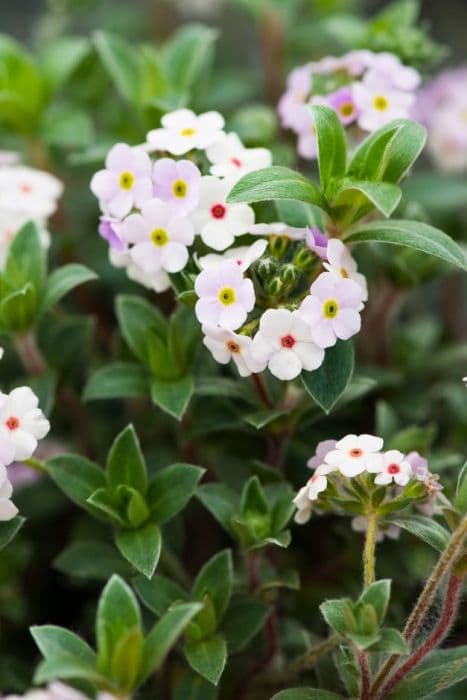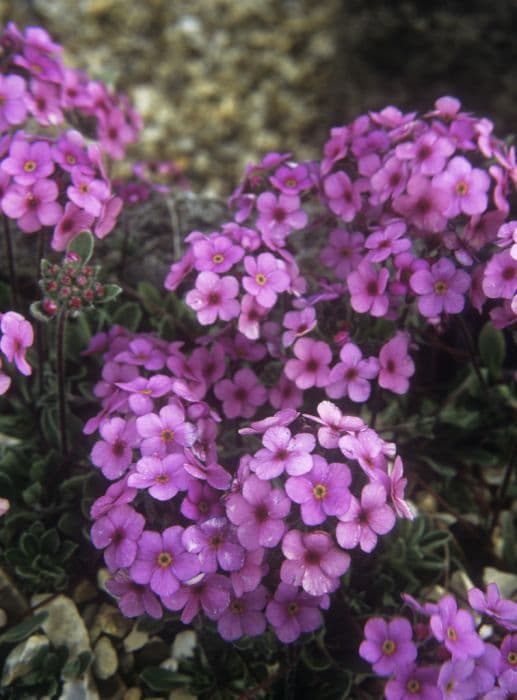Auricula Primula auricula hort. 'Fred Booley' (Au/d)

ABOUT
The 'Fred Booley' is a cultivated variety of the common garden flower known as the auricula, which is celebrated for its unique and striking appearance. This ornamental plant features a rosette of thick, fleshy leaves that are often a deep green in color, providing a lush backdrop for the showy flowers. The blooms of 'Fred Booley' are particularly captivating with their rich, velvety petals that may come in various hues. Such flowers are typically shaped like small rounded cups or discs and may feature a contrasting center, known as an "eye," that can be of a different color and adds to the visual interest of the plant. The detailing on the petals can be exquisite, with subtle gradations of color or distinctive patterns that may include dustings of farina, giving them a frosted look. The overall presentation of the 'Fred Booley' is one of elegance and sophistication, making it a highly sought-after variety by gardeners and flower enthusiasts for its ornamental value in garden beds, borders, and containers.
About this plant
 Names
NamesSynonyms
Bear's Ear Auricula, Mountain Cowslip, Auricula Primrose.
Common names
Primula auricula 'Fred Booley'
 Toxicity
ToxicityTo humans
The plant commonly known as Auricula is not considered highly toxic to humans. However, like many members of the Primula genus, it can cause mild irritation if ingested, or allergic reactions when in contact with sensitive skin. If any parts of the plant are consumed, there could be gastrointestinal discomfort such as nausea or vomiting. Direct skin contact with the sap can result in dermatitis in sensitive individuals. It is advisable to handle plants with caution and wash hands afterward to prevent potential skin irritation.
To pets
Auricula may have similar effects on pets as it does on humans, although it is not specifically known to be highly toxic to animals. If a pet ingests part of the plant, it could experience mild gastrointestinal upset, such as vomiting or diarrhea. Additionally, skin contact with the plant's sap may result in dermatitis in some animals. As with humans, caution should be taken to prevent pets from ingesting or coming into contact with the plant, and any incidents of ingestion or adverse reactions should be discussed with a veterinarian.
 Characteristics
CharacteristicsLife cycle
Perennials
Foliage type
Evergreen
Color of leaves
Green
Flower color
Mixed
Height
6 inches (15 cm)
Spread
6 inches (15 cm)
Plant type
Herb
Hardiness zones
5
Native area
Europe
Benefits
 General Benefits
General Benefits- Attracts pollinators: Primula auricula, commonly known as Auricula, is known to attract bees and butterflies, aiding in pollination of surrounding plants.
- Aesthetic appeal: Auricula flowers add vibrant color to gardens which can enhance the overall visual appeal of the landscape.
- Easy to grow: Auriculas are relatively easy to cultivate and can grow in a variety of soil conditions, making them accessible for many gardeners.
- Compact size: With a small and compact growth habit, Auriculas are well-suited for rock gardens, borders, and containers where space is limited.
- Versatility: The plant's colorful and diverse range of blooms make it a versatile choice for garden design, working well in both traditional and contemporary settings.
- Seasonal interest: Auriculas typically bloom in early spring, providing interest at a time when many other plants have not yet started growing.
 Medical Properties
Medical PropertiesThis plant is not used for medical purposes.
 Air-purifying Qualities
Air-purifying QualitiesThis plant is not specifically known for air purifying qualities.
 Other Uses
Other Uses- Primula auricula, often simply called Auricula, can be used in edging for walkways and borders due to its compact growth habit, offering a colorful edge during its blooming season.
- Auricula flowers can be pressed and used in floral crafts such as making bookmarks, greeting cards, or decorating picture frames for a touch of natural beauty.
- The flowers can be crystallized and used as an edible decoration on cakes and desserts, giving a unique and attractive finish.
- Auriculas can be potted and grown indoors as part of a container garden, adding a splash of color to interior spaces.
- These plants can be used in rock garden designs, as they typically enjoy well-drained soil and can thrive in the nooks and crannies between rocks.
- The leaves of Auricula can be used in creating botanical prints, a process where the plant's shape and texture are transferred onto paper or fabric.
- Auriculas can serve as a natural color guide for artists, as their varied hues can inspire color palettes for various art projects.
- The plant's unique appearance makes it a suitable subject for botanical illustration, an educational art form that accurately depicts the form and details of plant species.
- Used in thematic gardens, Auriculas can contribute to a Shakespearean or Elizabethan garden theme, as they were popular during those historical periods.
- Dried Auricula flowers can be incorporated into potpourri mixes, adding both color and a subtle natural fragrance to the blend.
Interesting Facts
 Feng Shui
Feng ShuiThe Auricula is not used in Feng Shui practice.
 Zodiac Sign Compitability
Zodiac Sign CompitabilityThe Auricula is not used in astrology practice.
 Plant Symbolism
Plant Symbolism- Unfading Love: The Primula auricula, commonly known as Auricula, often symbolizes enduring or unfading love due to its perennial nature and the way it returns each year with vibrant blooms.
- Patience: Its growth pattern, with flowers appearing in the early spring, can represent patience and the anticipation for beauty and reward after a long wait.
- Admiration: The stunning, detailed patterns and rich colors of some auricula varieties like 'Fred Booley' can signify admiration for the intricate beauty and resilience found in nature.
- Pride: The unique and striking appearance of the Auricula, especially those with showy blooms, has historically been associated with pride, as they were often collected and shown off by enthusiasts in Auricula Theatres.
- Humility: Despite its standout beauty, the Auricula can also symbolize humility, as it is a small plant that often grows in modest conditions in the wild.
 Water
WaterAuriculas, like the 'Fred Booley', prefer to be kept moist but not waterlogged. Water them when the top inch of the soil feels dry to the touch, typically once every 7 to 10 days, depending on the climate and indoor conditions. Use room-temperature water, avoiding cold water to prevent shock. When watering, apply water slowly at the base of the plant until it begins to drain from the bottom of the pot; this should amount to approximately half a gallon over a month for an average-sized plant.
 Light
LightAuriculas thrive in bright, indirect sunlight. A north-facing or east-facing window is an ideal spot, as they can be sensitive to the harsh midday sun which can lead to scorching of the leaves. Ensure that the 'Fred Booley' receives several hours of indirect light daily for optimal growth, while avoiding prolonged exposure to direct sunlight, especially during the peak summer months.
 Temperature
TemperatureAuriculas like 'Fred Booley' prefer cooler temperatures and do not respond well to extreme heat. They can survive in temperatures as low as 50°F but should be protected from frost. The ideal temperature range for growing auriculas is between 60°F and 70°F. They can tolerate a maximum temperature of about 80°F, but it's best to provide some shade during the hotter parts of the day to prevent overheating.
 Pruning
PruningPrune auriculas like 'Fred Booley' to remove dead or dying leaves and spent flowers. This encourages new growth and prevents disease. Pruning is best done after the main flowering period, typically in the late spring or early summer. Gently pinch or cut off the faded blooms and any yellowing leaves.
 Cleaning
CleaningAs needed
 Soil
SoilThe Auricula, commonly known as Bear's Ear, requires a well-draining soil mix composed of equal parts loam, peat, and coarse sand. A small amount of fine gravel can also be added for improved drainage. The ideal soil pH for Auriculas is slightly acidic to neutral, ranging from 6.0 to 7.0.
 Repotting
RepottingBear's Ear should be repotted every one to two years to refresh the soil and allow for continued growth. It's best to repot after flowering in the spring, taking care not to damage the root system.
 Humidity & Misting
Humidity & MistingBear's Ear thrives in moderate humidity levels. Avoid extremely dry air, but also guard against overly humid conditions that can promote fungal diseases. Aim for a humidity level between 50-60%.
 Suitable locations
Suitable locationsIndoor
Place Bear's Ear in bright, indirect light; keep soil moist.
Outdoor
Plant in partial shade, shelter from heavy rain and hot sun.
Hardiness zone
4-8 USDA
 Life cycle
Life cycleThe life of the Primula auricula, commonly known as Auricula Primrose, begins with seed germination, typically occurring in a cool, moist environment. Once germinated, the seedling emerges and develops into a rosette of leaves at the soil surface. As the plant matures, it forms a deep taproot and perennary, which enables it to survive over multiple seasons. The Auricula Primrose typically blooms in the spring, producing clusters of bright, ornate flowers above its foliage, which are often a focal point of its cultivation. After pollination, which can be facilitated by insects, the flowers develop into capsules containing numerous tiny seeds. The plant then enters a period of dormancy during the colder months, only to reemerge and repeat the cycle in the following growing season.
 Propogation
PropogationPropogation time
Spring to Summer
The ideal time to propagate Primula auricula, also known as Auricula or Mountain cowslip, is in the late summer after flowering, when the plant's energy is focused on root development. The most popular method of propagation for 'Fred Booley' is through division. To propagate by division, carefully dig up the plant and gently separate the crowded clumps into smaller pieces, ensuring each new section has roots attached. Once divided, the sections can be replanted immediately at the same soil level as before, spaced about 6 to 8 inches (15 to 20 centimeters) apart to give them room to grow. This method allows for quick establishment of new plants, which will often bloom by the following spring. Keep the newly planted divisions well-watered and protected from extreme sunlight until established.









